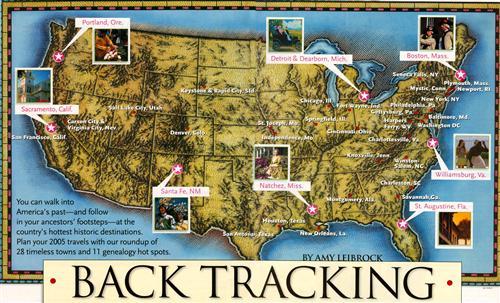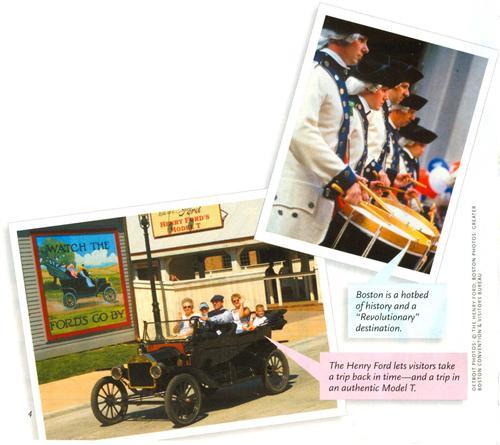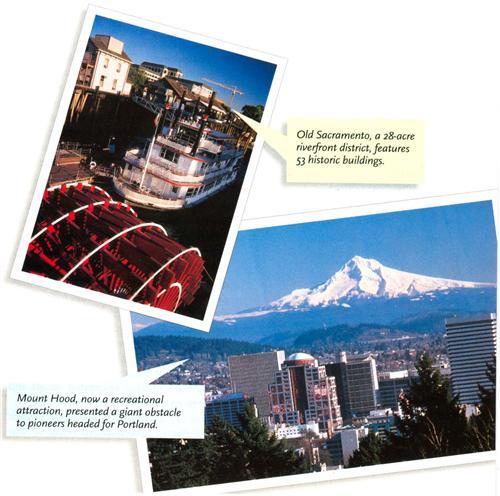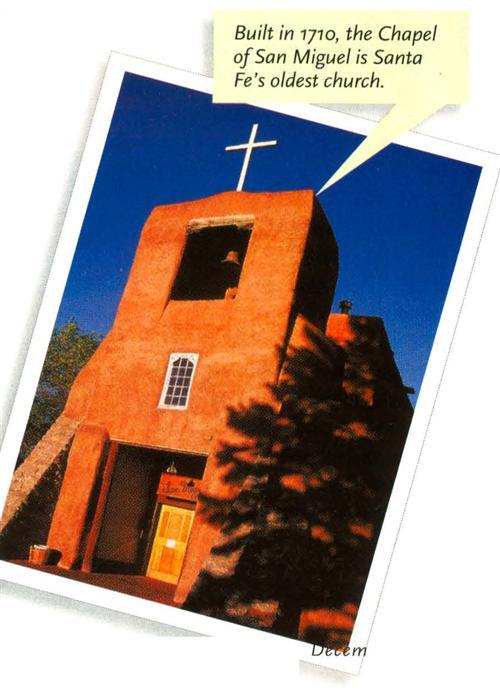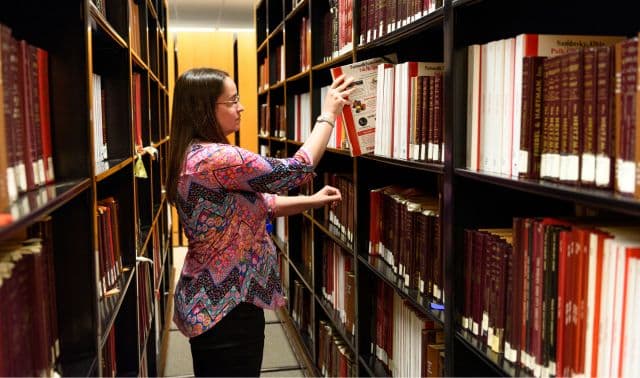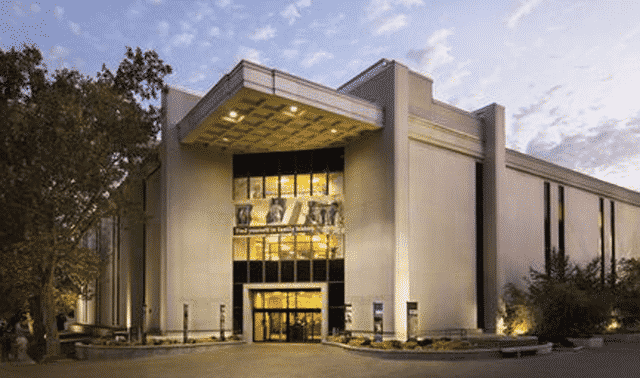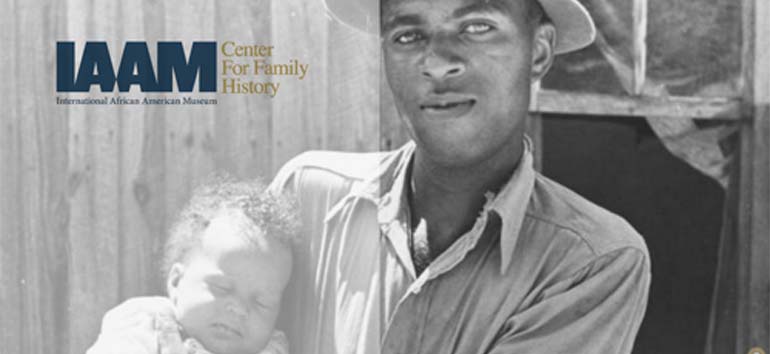Sign up for the Family Tree Newsletter Plus, you’ll receive our 10 Essential Genealogy Research Forms PDF as a special thank you!
Get Your Free Genealogy Forms
"*" indicates required fields
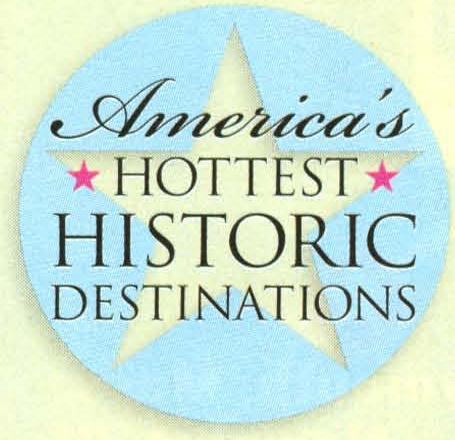
learn what your forebears’ lives were actually like. You aim to understand their trials and triumphs, to envision their everyday experiences and to discover their roles in shaping our collective past.
But you won’t find the answers you’re after in microfilm rolls or computer files. And you’ll have a tough time imagining other eras amidst the skyscrapers and strip malls that make up modern cityscapes. So where can you step into your ancestors’ shoes? We searched high and low for America’s hottest historic destinations — places where yesterday remains as vibrant as today, and you can truly experience history as your forebears lived it. We finally settled on 28 timeless towns that represent our nation’s (and your families’) diverse historical, cultural and geographic backgrounds. Our roundup highlights eight spectacular spots across America, and gives snapshots of 20 more heritage havens, so you can start planning a getaway to your ancestors’ day.
Boston, Mass.
Our country’s Revolutionary past seems to seep from every cobblestone in Boston, which is why the best way to explore it is on foot. The city has established a number of “trails” to let visitors discover Boston at their own pace.
The Immigrant Heritage Trail highlights parks, side streets, churches, cemeteries and historic buildings that are part of Boston’s ethnic tapestry. For information on the trail and links for researching your own Boston roots, visit <www.bostonfamilyhistory.com>.
A historically anti-slavery city, Boston has deep African-American roots. The city’s Museum of Afro-American History (617-725-0022, <www.afroammuseum.org>), a stop along the 1.6-mile Black Heritage Trail, tells the story of African-Americans during the Colonial years.
Beginning on Boston Common, America’s oldest park, a wide, red line points the way along the Freedom Trail. This 2.5-mile path winds its way through the central city, Old Boston and the North End, and then over the Charles River to Charlestown, ending at Bunker Hill. It encompasses many key Revolutionary sites, including the Old State House (where the Boston Massacre took place), Paul Revere’s house and the final resting places of John Hancock and Boston’s founder, John Winthrop. Contact the Boston National Historical Park (617-242-5642, <www.nps.gov/bost>) for guided tours, or grab a map and forge your own way.
Bed-and-breakfasts abound here, especially in the bohemian South End. Contact the Bed and Breakfast Agency of Boston (800-248-9262, <www.boston-bnbagency.com>).
Detroit & Dearborn, Mich.
Established in the early 18th century as a French fur-trading post, Detroit is better known for its automotive history. In 1896, Henry Ford drove his first car 9 miles from Detroit to his home in Dearborn, setting the stage for the city to become the center of the 20th-century American automotive industry.
Ford’s interest in ingenuity and invention also laid the framework for Dearborn’s The Henry Ford, which includes the Henry Ford Museum and Greenfield Village <www.hfmgv.org>. Ford began planning his museum in the 1920s, and now it’s a 12-acre indoor collection of objects of innovation. It chronicles the evolution of the car in American life, complete with more than 100 vehicles and a 1940s roadside diner. Visitors also will see Edgar Allan Poe’s writing desk, the limousine in which John F. Kennedy was shot and the Oscar Mayer Wienermobile.
Greenfield Village is a conglomeration of reconstructed historical sites that played a part in America’s shift from an agricultural to industrial society: Ford’s birthplace, Thomas Edison’s laboratory, an 1880s Ohio sheep farm and the Wright brothers’ home and cycle shop — all staffed by costumed presenters.
With its proximity to Canada, Detroit was a major stop on the Underground Railroad, making it a logical home for the Museum of African-American History (313-494-5800, <www.maah-detroit.org>), the largest of its kind. Its permanent exhibitions chronicle 400 years of African-American heritage.
Natchez, Miss.
Situated 120 miles northwest of New Orleans on the banks of the Mississippi River, Natchez was the heart of the “Cotton Kingdom” in the 1840s to 1860s. The city takes pride in its well-preserved antebellum past and gives visitors endless opportunities to step into its pocket of Southern heritage.
The Natchez National Historical Park (601-446-5790, <www.nps.gov/natc>) showcases cornerstones of Natchez history. Melrose, an 80-acre estate built by lawyer and plantation owner John T. McMurran, includes a Greek Revival mansion, restored slave quarters, formal gardens and outbuildings. Don’t miss the newly renovated William Johnson House, the former residence of a freed slave.
Scores of antebellum homes and churches are open year-round, but the best time to visit is during the Natchez Pilgrimage Tours (800-647-6742, <www.natchezpilgrimage.com>) in spring and fall. Each day, hoopskirted hostesses guide visitors through dozens of antebellum homes, and the town hosts lively programs every evening. For example, the Southern Road to Freedom, performed by the Holy Family Choir, chronicles the African-American experience in Natchez from the Colonial period to today.
Hundreds of years before cotton reigned, this area was home to the Natchez Indians, mound builders who lived here until the French drove them out in 1729. The Grand Village of the Natchez Indians (601-446-6502, <www.mdah.state.ms.us/hprop/gvni.html>) preserves what’s left of their civilization. The site features a museum, a reconstructed Natchez house and three ceremonial mounds.
Natchez brims with pre-Civil War and Victorian bed-and-breakfasts, such as the 26-acre Monmouth Plantation (800-828-4531, <www.monmouthplantation.com>).
Portland, Ore.
Though ultra-modern light rail has supplanted the Conestoga-wagon trains of Portland’s early days, the pioneers’ adventurous spirit still lingers. You can explore their legacy here and in nearby Oregon City and Vancouver, Wash.
Just across the Columbia River from Portland, Fort Vancouver (800-832-3599, <www.nps.gov/fova>) serves as a perfect starting point to learn about the region’s pioneer heritage. The British established the fort in 1825 as headquarters for the Hudson Bay Company; when the Brits abandoned the fort 24 years later, the US Army moved in and dubbed it Camp Vancouver. Today the site features reconstructed 19th-century buildings and historical re-enactments. And its Public Archaeology Program involves visitors in the ongoing excavations through special activities and tours. Across the street, don’t miss Officer’s Row: 21 Victorian homes built for officers stationed at Camp Vancouver.
Twenty miles south of Portland lies Oregon City — where pioneers could file claims for free land. At the End of the Oregon Trail Interpretive Center (503-657-9336, <www.endoftheoregontrail.org>), three buildings shaped like covered wagons house theaters and an exhibit hall that take visitors on the rugged journey thousands of pioneers endured. Oregon City is dotted with several other historical houses and museums worth exploring.
Back in Portland, save time for the Oregon History Center (503-306-5198, <www.ohs.org>), a rich repository of Oregon artifacts. The Oregon Historical Society‘s research library allows visitors to access its extensive collection of books, journals, maps, photographs and countless hours of oral histories.
Within walking distance of the Oregon History Center is the Governor Hotel (800-554-3456, <www.govhotel.com>), which opened in 1909 and features Lewis and Clark-inspired lobby decor.
Sacramento, Calif.
Sacramento and California history are forever intertwined with the small town of Coloma, where gold was discovered on Jan. 24, 1848. In just two years, Sacramento’s population shot from 1,000 to 40,000 as it became the main trading site for the ensuing gold rush.
Today both towns offer ample sites for exploring the region’s enterprising past. In Coloma, 40 miles east of Sacramento, the Marshall Gold Discovery State Historical Park (530-622-3470, <www.parks.ca.gov>) commemorates James Wilson Marshall’s big find with restored buildings, living history demonstrations and a mining exhibit. You even can try your luck at panning for gold in the American River.
The transcontinental railroad line, which terminated in Sacramento, helped to fuel the region’s prosperity. Learn about the railroading era at the California State Railroad Museum (916-445-6645, <www.csrmf.org>). Exhibits explain how trains work, how track is laid and what it was like to travel by rail. The museum is located in Old Sacramento <www.oldsacramento.com>, a 28-acre riverfront district of 53 historic buildings. You can tour this Old West enclave on foot or horse-and-buggy and stay aboard the Delta King (800-825-5464, <www.deltaking.com>), a 1927 restored riverboat.
The neighborhood’s landmark attractions include the Big Four Building, where the transcontinental railroad was planned; the B.F. Hastings Building, the end of the Pony Express; and the California Military Museum (916-442-2883, <www.militarymuseum.org>), an interpretive look at our nation’s military past.
St. Augustine, Fla.
You can’t get much more historic than St. Augustine — after all, this 439-year-old town was the first permanent European settlement in the United States. Many of the city’s attractions revolve around this claim to fame: You can browse the original “superstore” at the Oldest Store Museum (904-829-9729), experience how living quarters have evolved in the Oldest House (904-824-2872), get history lessons at the Oldest Wooden School-house (888-653-7245) and learn about the history of Florida’s penal system at the Old Jail (904-829-3800).
For a taste of Spanish colonial life, stroll through the Spanish Quarter Village (904-825-6830). This living history museum re-creates the homes, gardens and workshops of 1740s St. Augustine. Role-playing guides bring everything to life.
St. Augustine also is home to the Fountain of Youth Archaeological Park (800-356-8222), where Ponce de Leon landed in 1513. Visitors can see the fabled source of eternal life and explore artifacts of the Timucua Indian settlement, one of the most important archaeological sites in the Southeast. Links to most of the above attractions are at <www.oldcity.com>.
St. Augustine’s historical gem is the three-centuries-old Castillo de San Marcos (904-829-6506, <www.nps.gov/casa>). This large masonry fort features 12-foot-thick walls and symbolizes a tumultuous history — over time, St. Augustine changed hands between Spain, England and the United States (plus its brief stint as part of the Confederacy). Exhibits and living history demonstrations lead visitors through its colorful past.
Several area companies offer guided tours by foot, carriage, boat or train. To explore St. Augustine’s spooky side, contact Ghost Tours of St. Augustine (888-461-1009, <www.aghostlyexperience.com>), which claims its stories are thoroughly researched through historical documents and diaries.
If you’re willing to splurge on lodging, look into the 1888 Moorish Revival-style Casa Monica Hotel (800-648-1888, <www.casamonica.com>).
Santa Fe, NM
With its colorful tapestry of Spanish, Pueblo Indian and pioneer history combined with striking natural beauty, Santa Fe offers something for every heritage buff.
The historic Plaza downtown has been the nucleus of the city’s activity for nearly 400 years. Once the terminus of the Santa Fe Trail, it’s now home to a cluster of historic monuments, galleries and museums, and serves as a staging ground for festivals and fairs.
On the Plaza’s north side sits the Palace of the Governors (505-827-6483, <www.palaceofthegovemors.org>), the oldest government building in the United States. Constructed in 1610 as Spain’s seat of government for the southwest, it now houses a museum that recounts the region’s history through thousands of artifacts and period rooms.
The Museum of Indian Arts & Culture (505-476-1250, <www.museumofnewmexico.org>) explores the evolution of the region’s earliest people through ancient artifacts. Visitors learn the area’s stories by listening to recorded voices of American Indians.
Reserve a day to experience Spanish colonial New Mexico at El Rancho de las Golondrinas (505-471-2261, <www.golondrinas.org>), a living history museum located just south of Santa Fe. Original and reconstructed buildings and costumed “villagers” bring this historic ranch to life, especially during theme weekends. For example, the Civil War weekend each May features artillery and marching demonstrations, re-created camps and battle re-enactments.
Santa Fe and environs brim with historic plazas, districts and missions. Most of New Mexico’s 19 pueblos welcome visitors to respectfully observe their residents’ way of life and some tribal ceremonies. Contact the Santa Fe Convention and Visitors Bureau (800-777-2489, <www.santafe.org>) for a visitors guide.
For lodging on the Plaza, check into La Fonda (800-523-5002, <www.lafondasantafe.com>), a 1922 hotel decorated with Southwestern artwork.
Williamsburg, Va.
No talk of living history destinations is complete without mentioning Colonial Williamsburg (800-447-8679, <www.history.org>), the town that served as an incubator of American ideals. Here, patriots such as Patrick Henry, George Washington and Thomas Jefferson challenged British authority and called for American independence.
You easily can fill several days of a vacation here; it’s the largest outdoor living history museum in the country. The 172-acre Historic Area consists of 88 original 18th-century structures and hundreds of other reconstructed buildings. Visitors will encounter countless costumed interpreters. You might run into Thomas Jefferson, a wig-maker or other regular “locals.” These reenactors don’t just look the part: Strike up a conversation, and they’ll impart the same knowledge and opinions as their actual Colonial counterparts.
At Colonial Williamsburg, you can get your hands dirty with history: Test your skills at 1700s-style brickmaking, gardening, housekeeping, crafting and more. You even can see what it’s like to fight a fire with a bucket brigade or “enlist” in the military.
To immerse your family in even more history, check into one of Williamsburg’s 28 Colonial Houses for the night. All are furnished with authentic period reproductions and antiques, and each has its own character.
While in the area, many tourists also visit Jamestown, America’s first permanent English settlement, and Yorktown, where the Revolutionary War ended. Both are only a few miles away.
DESTINATION: HISTORY
NOT-SO-NEW ENGLAND
• Plymouth, Mass.
Make a pilgrimage to the Mayflower II, Plimouth Plantation (508-746-1622, <www.plimoth.org>) and the remains of the Revolutionary War-era Fort Independence at Fort Revere Park (617-727-4468, <www.fortreverepark.org>).
Plymouth County Conventionand Visitors Bureau: (800) 231-1620, <www.seeplymouth.com>
• Newport, Rl
This Colonial center of religious freedom is also home to Fort Adams (<www.fortadams.org>), the largest coastal fortification in the country. Experience what Newport was like a century ago by touring some of the city’s exquisite mansions (401-847-1000, <www.newportmansions.org>). Newport County Convention and Visitors Bureau: (800) 976-5122, <www.gonewport.com>
• Mystic, Conn.
You’ll immerse yourself in history at Mystic Seaport (888-973-2767, <www.mysticseaport.org>), a maritime museum with dozens of historic buildings and berthed ships. See how times have changed at the Denison Homestead Museum (860-536-9248, <www.visitconnecticut.com/denisonhomestead>), where each room represents a different era in the family’s 200-year history.
Olde Mistick Village: (860) 536-4941, <www.oldemistickvillage.com>
MID-ATLANTIC THROWBACKS
• Philadelphia, Pa.
Our nation’s first capital, the hometown of Benjamin Franklin and Betsy Ross, boasts some of America’s most revered historic sites. Visit Independence National Historical Park (215-965-2305, <www.nps.gov/inde>), called the most historic square mile in the nation, to see the Liberty Bell and Independence Hall. And don’t forget the “Revolutionary” attractions at nearby Valley Forge National Historical Park (610-834-1550, <www.valleyforge.org>).
Philadelphia Convention and Visitors Bureau: (215) 599-0776, <www.pcvb.org>
• Gettysburg, Pa.
Tour the site of the Civil War’s most famous battle at Gettysburg National Military Park (717-334-1124, <www.nps.gov/gett>). You also can visit the Wills House, where President Lincoln wrote the Gettysburg address.
Gettysburg Convention and Visitors Bureau: (717) 334-6274, <www.gettysburg.com>
•Seneca Falls, NY
Retrace the steps of Elizabeth Cady Stanton and Lucretia Mott at the birthplace of the women’s suffrage movement. Two must-see attractions are the Women’s Rights National Historical Park (315-568-2991, <www.nps.gov/wori>) and the National Women’s Hall of Fame (315-568-8060, <www.greatwomen.org>).
New York State Tourism: (800) 225-5697, <www.iIoveny.com>
• Harpers Ferry, WV
Abolitionist John Brown’s raid on the Harpers Ferry armory brought national attention to slavery issues just before the Civil War. Because of its location on a railroad, the town changed hands eight times as the North and South battled.
Harpers Ferry National Historical Park: (304) 535-6298, <www.nps.gov/hafe/home.htm>
• Baltimore, Md.
The flag at Baltimore’s Fort McHenry (410-962-4290, <www.nps.gov/fomc>) inspired Francis Scott Key to write what would later become the US national anthem. At Baltimore’s Inner Harbor, you can climb aboard the USS Constellation (410-539-1797, <www.constellation.org>), the Navy’s last all-sail warship — and the only Civil War-era ship still afloat.
Baltimore Area Convention and Visitors Association: (877) 225-846673, <www.baltimore.org>
HISTORY CENTRAL
• Springfield, III.
Honest Abe’s legacy lives on in the land of Lincoln’s capital city. You can salute the 16th president at several historic sites, including his home, presidential library and tomb. Architect Frank Lloyd Wright also left his mark in Springfield, with the 1904 Dana-Thomas House (217-782-6776, <www.dana-thomas.org>).
Springfield Convention and Visitors Bureau: (800) 545-7300, <www.visit-springfieldillinois.com>
•St. Joseph, Mo.
This frontier town served as a starting point for Oregon Trail pioneers, as well as the Pony Express. The Pony Express National Museum (800-530-9530, <www.ponyexpress.org>) delivers the history of this postal-service precursor, and the Jesse James Home Museum — where the outlaw met his demise — recalls the rougher side of frontier life. Examine historical treatments for mental maladies at the Glore Psychiatric Museum (877-387-2310, <www.gloremuseum.org>).
St. Joseph Convention and Visitors Bureau: (800) 785-0360, <www.stjomo.com>
• Keystone and Rapid City, SD
The Black Hills hold plenty of history — and we’re not just talking about the vintage visages of Mount Rushmore (605-574-2523, <www.nps.gov/moru>). Head just 17 miles west to tour the Crazy Horse Memorial (605-673-4681, <www.crazyhorse.org>) and Devils Tower, an American Indian worship site and the first US national monument (307-467-5283, <www.nps.gov/deto>). Then relive the late 19th century at Big Thunder Gold Mine and 1880 Town (605-344-2259, <www.michietavern.com>).
Rapid City Convention and Visitors Bureau: (800) 487-3223, <www.rapidcitycvb.com>
SOUTHERN BELLES
• Charlottesville, Va.
Tour Thomas Jefferson’s Monticello (434-984-9800, <www.monticello.org>) – the only American home to be designated a World Heritage Site — then drop by the nearby Michie Tavern for a taste of the Old South (434-977-1234, <www.michietavern.com>).
Charlottesville-Albemarle Convention and Visitors Bureau: (877) 386-1102, <www.charlottesvilletourism.org>
•Winston-Salem, NC
You’ve probably heard of Old Salem <www.oldsalem.org>, a Moravian settlement founded in 1766. But it’s not this area’s oldest settlement: Moravians established Bethabara 13 years earlier. Bethabara Park <www.bethabarapark.org> now hosts history demonstrations.
Winston-Salem Convention and Visitors Bureau: (866) 728-4200, <www.visitwinstonsalem.com>
• Charleston, SC
Learn about Southern secession at Fort Sumter (843-883-3123, <www.nps.gov/fosu>), site of the first shots fired in the Civil War. Then take a walking tour of Charleston’s charming historic homes (see <www.historiccharleston.org>).
Charleston Convention and Visitors Bureau: (800) 774-0006, <www.charlestoncvb.com>
• Savannah, Ga.
When you visit Savannah, take a walking tour to see some of the locales featured in Midnight in the Garden of Good and Evil <www.savannahnow.com/goodandevil/tour>. The Coastal Heritage Society <www.chsgeorgia.com> preserves sites such as Old Fort Johnson, Battlefield Park and the Savannah History Museum.
Savannah Convention and Visitors Bureau: (877) 728-26624, <www.savannah-visit.com>
• Montgomery, Ala.
Dedicated to the woman who helped spark the civil rights movement, the Rosa Parks Library and Museum (334-241-8661, <www.tsum.edu/museum>) tells Parks’ story and how it led to the yearlong bus boycott. The moving Civil Rights Memorial (334-264-0286) honors those who died in the struggle for racial justice, and Old Alabama Town (888-240-1850, <www.oldalabamatown.com>) whisks you back to the Heart of Dixie’s early days.
Montgomery Convention and Visitors Bureau: (800) 240-9452, <www.visitingmontgomery.com>
• New Orleans, La.
Explore your French, Spanish and Creole roots in the historic French Quarter <www.frenchquarter.com>. This vibrant neighborhood has been around for nearly 300 years. Don’t forget to peruse the lively French Market and stop by the Musee Conti Wax Museum (800-233-5405, <www.neworleanswaxmuseum.com>).
New Orleans Convention and Visitors Bureau: (800) 672-6124, <www.neworleanscvb.com>
THE OLD WEST (AND SOUTHWEST)
• Virginia City & Carson City, Nev.
Kick back at the saloon and try your hand at panning for gold in Virginia City <www.virginiacity-nv.org>. The gold and silver boom of the 1860s and ’70s spawned and sustained this town, which once held nearly half of Nevada’s population. In Carson City, take a walking tour of historic homes on the Kit Carson Trail.
Carson City Convention and Visitors Bureau: (800) 638-2321, <www.carson-city.org>
• San Francisco, Calif.
From Chinatown to Fisherman’s Wharf, San Francisco is a “golden gate” to yesterday. You’ll find itineraries for historical walking tours at <www.goldrushtrail.org>. Or ride the fabled cable cars, whose past you can explore at the Cable Car Museum (415-474-1887, <www.cablecarmuseum.com>). On Alcatraz <www.nps.gov/alcatraz>, you can visit the infamous prison and learn about the island’s military history and American Indian occupation.
San Francisco Convention and Visitors Bureau: (415) 283-0177, <www.sfvisitor.com>
• San Antonio, Texas
“Remember the Alamo” when you visit San Antonio. The 1836 stand against the Mexican army is a source of pride for Texans — and the site welcomes 2.6 million visitors each year <www.thealamo.org>. Experience old-time shopping at El Mercado in Market Square, patterned after a traditional Mexican market.
ADVERTISEMENT

